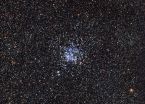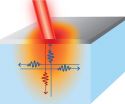(Press-News.org) Having the possibility to measure magnetic properties of materials at atomic precision is one of the important goals of today's experimental physics. Such measurement technique would give engineers and physicists an ultimate handle over magnetic properties of nano-structures for future applications. In an article published in Physical Review Letters researchers propose a new method, utilizing properties of the quantum world – the phase of the electron beam – to detect magnetism with atom-by-atom precision.
The electron microscope is a fascinating instrument. It uses a highly accelerated electron beam, which passes right through the sample. The way how the beam scatters in that process, gives scientists a whole lot of information about the sample itself. Today it allows us to watch individual atoms and distinguish them by their atomic number. Scientists even learned how to extract a position of every single atom in a nanoparticle. Much of this became possible thanks to the invention of an aberration corrector – a device, which sharpens the image of microscope, the same way as glasses help our eyes.
There is however one domain, where microscopy is still relatively in its beginnings and that is the study of magnetic properties. A team of three scientists, Jan Rusz from Uppsala University, Sweden, Juan-Carlos Idrobo from Oak Ridge National Laboratory, USA, and Somnath Bhowmick from Indian Institute of Technology, India, have proposed a new way, which should bring the resolution in magnetic studies on par with watching individual atoms.
The trick lies in an inovative use of the aberration corrector - "the glasses of the microscope". It is used to correct all errors of the microscope optics, except for one specific distortion, which is tuned to the symmetry of the measured crystal. Imagine your glasses intentionally curved in a specific way, which allows you to see something, that you could not spot before. In the strange world of quantum mechanics this is exactly what happens. The distortion enhances the magnetic signal, which can be then easily measured.
"With this new method, we bring the atomic resolution magnetic measurements to about 400 laboratories world-wide, which are equipped with modern scanning transmission electron microscopes with aberration correctors", says Jan Rusz, and expects that the first experimental confirmations will come very soon.
INFORMATION:
Ján Rusz, Juan-Carlos Idrobo, Somnath Bhowmick (2014) Achieving atomic resolution magnetic dichroism by controlling the phase symmetry of an electron probe, Physical Review Letters, 113, 145501
DOI: 10.1103/PhysRevLett.113.145501
Novel approach to magnetic measurements atom-by-atom
2014-10-01
ELSE PRESS RELEASES FROM THIS DATE:
Platinum meets its match in quantum dots from coal
2014-10-01
Graphene quantum dots created at Rice University grab onto graphene platelets like barnacles attach themselves to the hull of a boat. But these dots enhance the properties of the mothership, making them better than platinum catalysts for certain reactions within fuel cells.
The Rice lab of chemist James Tour created dots known as GQDs from coal last year and have now combined these nanoscale dots with microscopic sheets of graphene, the one-atom-thick form of carbon, to create a hybrid that could greatly cut the cost of generating energy with fuel cells.
The research ...
Predicting the future course of psychotic illness
2014-10-01
Psychiatry researchers from the University of Adelaide have developed a model that could help to predict a patient's likelihood of a good outcome from treatment - from their very first psychotic episode.
The model is based on a range of factors, including clinical symptoms, cognitive abilities, MRI scans of the brain's structure, and biomarkers in the patient's blood.
Speaking in the lead up to World Mental Health Day (10 October), the University's Head of Psychiatry, Professor Bernhard Baune, says the model is a revolutionary idea for psychiatric care, and is aimed ...
Fat chats: The good, the bad and the ugly comments
2014-10-01
Cyberbullying and hurtful 'fat jokes' are disturbingly prevalent in the social media environment, especially on Twitter, says Wen-ying Sylvia Chou of the National Institutes of Health in the US. Chou is lead author of a study in Springer's journal Translational Behavioral Medicine which analyzed well over a million social media posts and comments about weight matters. However, the researchers were also happy to find that the news was not all bad: many instances of support and advice were also observed, especially on blogs and forums.
The study is one of the first to analyze ...
Fall in monsoon rains driven by rise in air pollution, study shows
2014-10-01
Emissions produced by human activity have caused annual monsoon rainfall to decline over the past 50 years, a study suggests.
In the second half of the 20th century, the levels of rain recorded during the Northern Hemisphere's summer monsoon fell by as much as 10 per cent, researchers say. Changes to global rainfall patterns can have serious consequences for human health and agriculture.
Scientists found that emissions of tiny air particles from man-made sources – known as anthropogenic aerosols – were the cause. High levels of aerosols in the atmosphere cause heat ...
Wild ducks take flight in open cluster
2014-10-01
Messier 11 is an open cluster, sometimes referred to as a galactic cluster, located around 6000 light-years away in the constellation of Scutum (The Shield). It was first discovered by German astronomer Gottfried Kirch in 1681 at the Berlin Observatory, appearing as nothing more than a fuzzy blob through the telescope. It wasn't until 1733 that the blob was first resolved into separate stars by the Reverend William Derham in England, and Charles Messier added it to his famous catalogue in 1764.
Messier was a comet hunter and the catalogue came into being as he was frustrated ...
Gene interacts with stress and leads to heart disease in some people
2014-10-01
DURHAM, N.C. – A new genetic finding from Duke Medicine suggests that some people who are prone to hostility, anxiety and depression might also be hard-wired to gain weight when exposed to chronic stress, leading to diabetes and heart disease.
An estimated 13 percent of people, all of whom are Caucasian, might carry the genetic susceptibility, and knowing this could help them reduce heart disease with simple interventions such as a healthy diet, exercise and stress management.
"Genetic susceptibility, psychosocial stress and metabolic factors act in combination to increase ...
Results of large-scale roll out of combination treatment for kala-azar in Eastern Africa
2014-10-01
Today in Bahir Dar, Ethiopia, at the occasion of the Leishmaniasis East Africa Platform meeting, which has gathered some 150 African and international leishmaniasis experts, results of a pharmacovigilance – or large-scale treatment safety and efficacy monitoring – plan, carried out by MSF, DNDi, and national partners in Kenya, Sudan, Uganda, and Ethiopia, were presented to key decision makers in order to boost patient access to treatment of kala-azar with the combination of Sodium Stibogluconate and Paromomycin (SSG&PM) in the region. In this large cohort of patients, treated ...
Long-acting insulin is safer, more effective for patients with Type 1 diabetes
2014-10-01
TORONTO, Oct. 1, 2014 – Long-acting insulin is safer and more effective than intermediate-acting insulin for patients with Type 1 diabetes, according to new research published in the BMJ.
Researchers looked at once-daily and twice-daily doses of both long- and intermediate-acting insulin, ranking their effectiveness, safety and cost-effectiveness.
"In patients with Type 1 diabetes, we found that long-acting insulin is superior to intermediate-acting insulin when it came to controlling blood sugar, preventing weight gain and treating severe hypoglycemia," said Dr. ...
All directions are not created equal for nanoscale heat sources
2014-10-01
Thermal considerations are rapidly becoming one of the most serious design constraints in microelectronics, especially on submicron scale lengths. A study by researchers from the University of Illinois at Urbana-Champaign has shown that standard thermal models will lead to the wrong answer in a three-dimensional heat-transfer problem if the dimensions of the heating element are on the order of one micron or smaller.
"As materials shrink, the rules governing heat transfer change as well," explained David Cahill, a professor of materials science and engineering at Illinois. ...
Microbes in Central Park soil: If they can make it there, they can make it anywhere
2014-10-01
Soil microbes that thrive in the deserts, rainforests, prairies and forests of the world can also be found living beneath New York City's Central Park, according to a surprising new study led by Colorado State University and the University of Colorado Boulder.
The research team analyzed 596 soil samples collected from across Central Park's 843 acres and discovered a stunning diversity of below-ground life, most of which had never been documented before.
Only 8.5 percent to 16.2 percent of the organisms discovered in the park soils, depending on their type, had been ...



